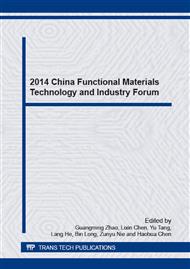p.78
p.82
p.88
p.93
p.99
p.105
p.109
p.114
p.122
Giant Magnetoimpedance in Fe73.5Cu1Nb2V1Si13.5B9 Nanocrystalline Ribbons
Abstract:
In the present work, the giant magnetoimpedance effect has been found in Fe73.5Cu1Nb2V1Si13.5B9 nanocrystalline ribbons. The optimum annealing temperature for obtaining largest GMI is about 550°C. Fe73.5Cu1Nb2V1Si13.5B9 with average grain size of 15 nm after annealing at 550°C for 30 min presents a magnetoimpedance of-74% at 700 kHz under H=90 Oe. The MI effect at high frequency is due to the change of Z via the variation of permeability or the penetration depth under the external field. The positive magnetoimpedance ΔZ/Z is 36% and positive magnetoresistance ΔR/R is 79% at H= 10 Oe and f=5MHz. We observe a huge magnetoreactance ΔX/X of –375% at a very low frequency of 50 kHz, which is a magnetoinduction effect due to the movement of domain wall. The smaller GMI for nanocrystalline Fe73.5Cu1Nb2V1Si13.5B9 ribbons annealed above 550°C is mainly connected with the decrease of permeability due to the precipitation of Fe2B phase in ribbons. Our results show that the partial substitution of expensive Nb by cheap V in FeCuNbSiB could be a successful way to prepare the GMI materials with high performance and low cost.
Info:
Periodical:
Pages:
99-104
Citation:
Online since:
December 2014
Authors:
Keywords:
Price:
Сopyright:
© 2015 Trans Tech Publications Ltd. All Rights Reserved
Share:
Citation:


